#Museum of Modern Art in Delhi
Text
Popular Museum of Modern Art in Delhi

Some of these techniques include Shadow Art, Kite Making, Photo Frames, Mask Making, Glass Painting, Paper Sculptures, and Fabric Collage among numerous others facilitated by the Museum Educators. KNMA being the popular museum of modern art in Delhi has other host of workshop series for different groups of people interested for attending simple painting classes in Delhi to more diverse, evolved and interesting art forms and skills.
0 notes
Text


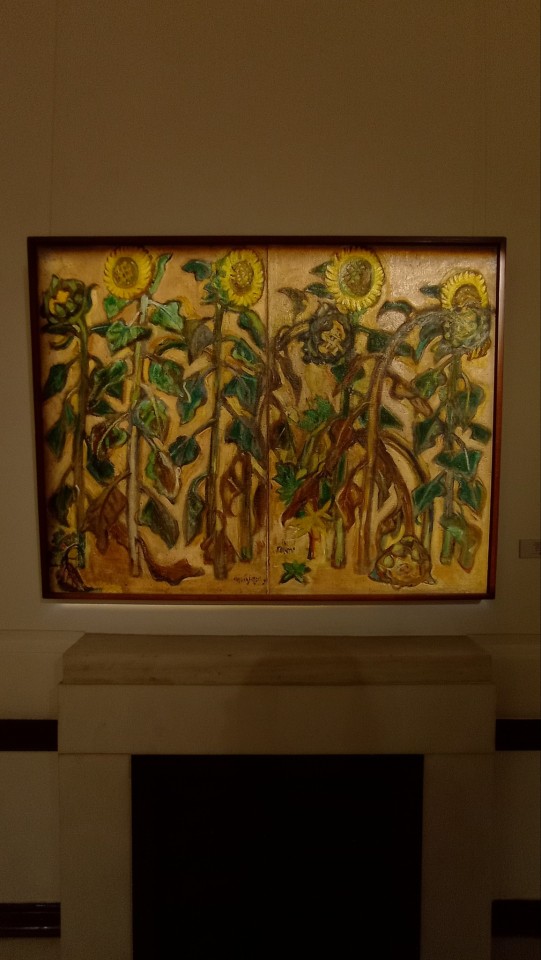

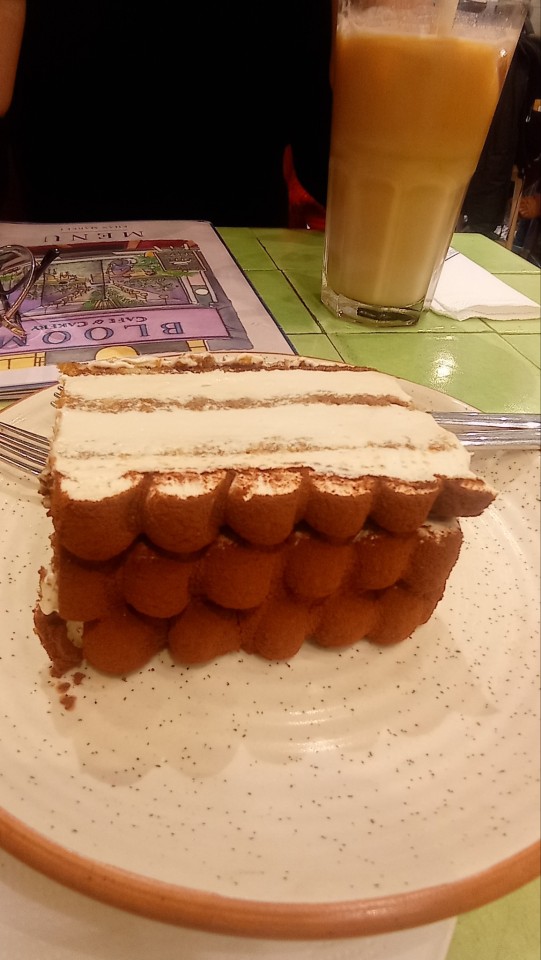
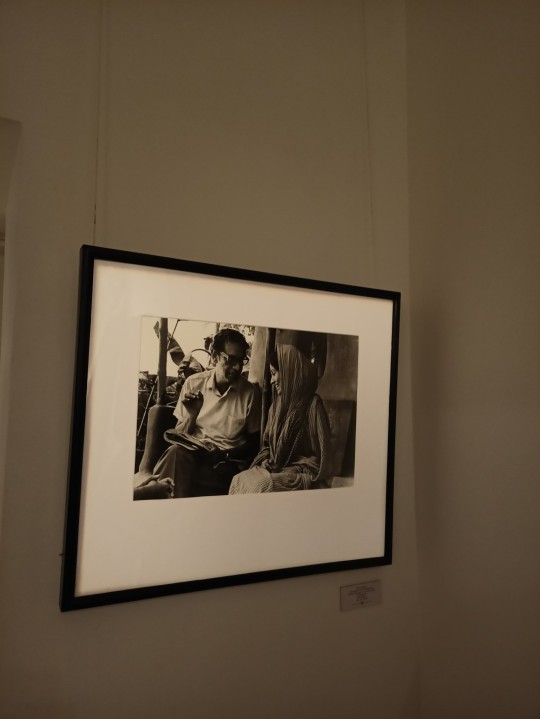


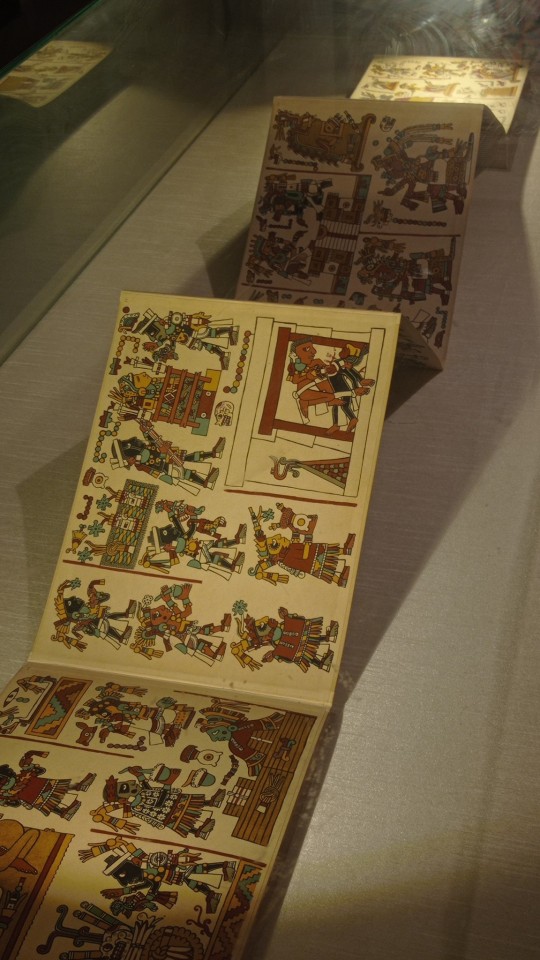
from my gallery (30/12/2023) - museum & cafe date with best friend <3
#national gallery of modern art#new delhi#museums#indian museums#dark academia#dark academia aesthetic#aesthetic#classic academia#classic academia aesthetic#light academia#light acadamia aesthetic#academia#moodboard#nostalgia#desi#being desi#tiramisu#coffee#cappuccino#visual art#graphic art#art history#artwork#art#art museum#chaotic academia#history#gallery#art gallery#mine
91 notes
·
View notes
Text
Inside the DAG x Jamini Roy house
For years now, DAG (previously Delhi Art Gallery) has been greater than a gallery. Almost three a long time previous, with the largest assortment of pre-modern and trendy Indian artwork, it has had uncommon collaborations — with the Archaeological Survey of India and the National Gallery of Modern Art at Dhrishyakala (Red Fort, Delhi) and with Ghare Baire (Old Currency Building, Kolkata), as an…
View On WordPress
#Artist Jamini Roy#Ballygunge Place#CEO Ashish Anand#DAG#Delhi Art Gallery#Iconic Masterpieces of Indian Modern Art#India Habitat Centre#Jamini Roy house#Jamini Roy House Artist Museum#Jamini Roy museum#Kolkata#National Museum#The National Gallery of Modern Art
0 notes
Link
KNMA being the popular Museum of Modern Art in Delhi has other host of workshop series for different groups of people interested for attending simple Painting Classes in Delhi to more diverse, evolved and interesting art forms and skills.
0 notes
Text
Origins of the Pibo: Let’s take a trip along the Silk Road.
1. Introduction to the garment:
Pibo 披帛 refers to a very thin and long shawl worn by women in ancient East Asia approximately between the 5th to 13th centuries CE. Pibo is a modern name and its historical counterpart was pei 帔. But I’ll use pibo as to not confuse it with Ming dynasty’s xiapei 霞帔 and a much shorter shawl worn in ancient times also called pei.
Below is a ceramic representation of the popular pibo.
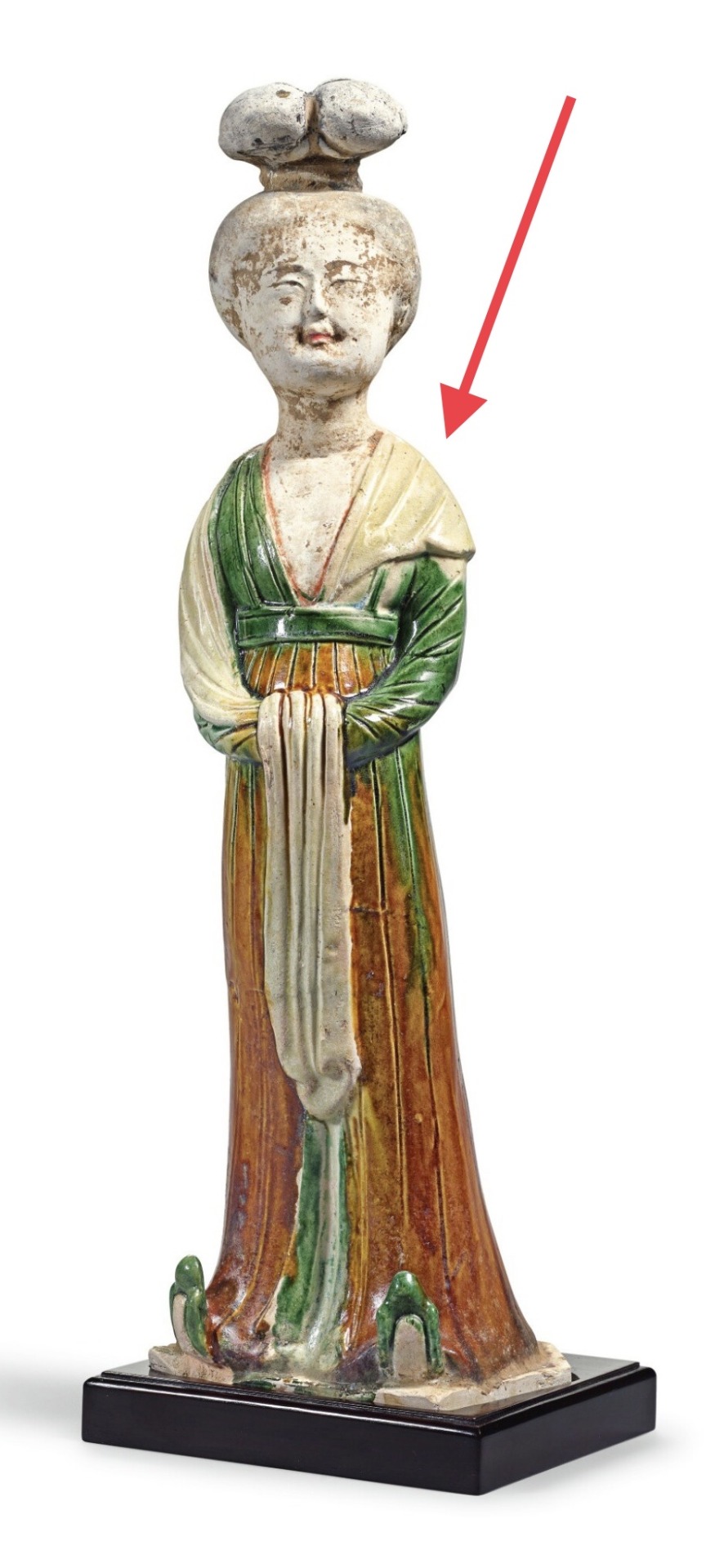
A sancai-glazed figure of a court lady, Tang Dynasty (618–690, 705–907 CE) from the Sze Yuan Tang Collection. Artist unknown. Sotheby’s [image source].
Although some internet sources claim that pibo in China can be traced as far back as the Qin (221-206 BCE) or Han (202 BCE–9 CE; 25–220 CE) dynasties, we don’t start seeing it be depicted as we know it today until the Northern and Southern dynasties period (420-589 CE). This has led to scholars placing pibo’s introduction to East Asia until after Buddhism was introduced in China. Despite the earliest art representations of the long scarf-like shawl coming from the Northern and Southern Dynasties period, the pibo reached its popularity apex in the Tang Dynasty (618–690 CE: 705–907 CE).
Academic consensus: Introduction via the Silk Road.
The definitive academic consensus is that pibo evolved from the dajin 搭巾 (a long and thin scarf) worn by Buddhist icons introduced to China via the Silk Road from West Asia.
披帛是通过丝绸之路传入中国的西亚文化, 与中国服饰发展的内因相结合而流行开来的一种"时世妆" 的形式. 沿丝绸之路所发现的披帛, 反映了丝绸贸易的活跃.
[Trans] Pibo (a long piece of cloth covering the back of the shoulders) was a popular female fashion period accessory introduced to China by West Asian cultures by way of the Silk Road and the development of Chinese costumes. The brocade scarves found along the Silk Road reflect the prosperity of the silk trade that flourished in China's past (Lu & Xu, 2015).
I want to add to the above theory my own speculation that, what the Chinese considered to be dajin, was most likely an ancient Indian garment called uttariya उत्तरीय.
2. Personal conjecture: Uttariya as a tentative origin to pibo.
In India, since Vedic times (1500-500 BCE), we see mentions in records describing women and men wearing a thin scarf-like garment called “uttariya”. It is a precursor of the now famous sari. Although the most famous depiction of uttariya is when it is wrapped around the left arm in a loop, we do have other representations where it is draped over the shoulders and cubital area (reverse of the elbow).
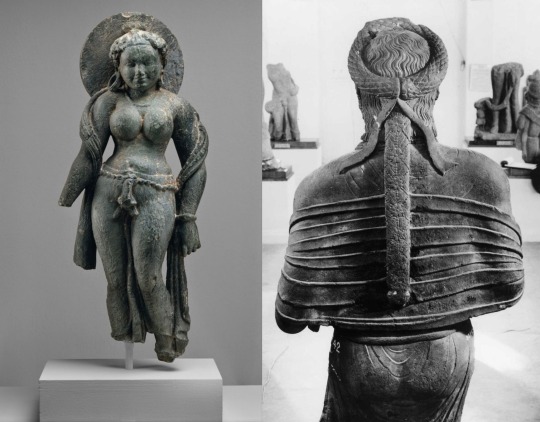
Left: Hindu sculpture “Mother Goddess (Matrika)”, mid 6th century CE, gray schist. Artist unknown. Looted from Rajasthan (Tanesara), India. Photo credit to Metropolitan Museum of Art, New York, United States [image source].
Right: Rear view of female statue possibly representing Kambojika, the Chief Queen of Mahakshatrapa Rajula, ca. 1st century CE. Artist unknown. Found in the Saptarishi Mound, Mathura, India. Government Museum, Mathura [image source].
Buddhism takes many elements from Hindu mythology, including apsaras अप्सरा (water nymphs) and gandharvas गन्धर्व (celestial musicians). The former was translated as feitian 飞天 in China. Hindu deities were depicted wearing clothes similar to what Indian people wore, among which we find uttariya, often portrayed in carvings and sculptures of flying and dancing apsaras or gods to show dynamic movement. Nevertheless, uttariya long predated Buddhism and Hinduism.
Below are carved representation of Indian apsaras and gandharvas. Notice how the uttariya are used.

Upper left: Carved relief of flying celestials (Apsara and Gandharva) in the Chalukyan style, 7th century CE, Chalukyan Dynasty (543-753 CE). Artist Unknown. Aihole, Karnataka, India. National Museum, New Delhi, India [image source]. The Chalukyan art style was very influential in early Chinese Buddhist art.
Upper right: Carved relief of flying celestials (gandharvas) from the 10th to the 12th centuries CE. Artist unknown. Karnataka, India. National Museum, New Delhi, India [image source].
Bottom: A Viyadhara (wisdom-holder; demi-god) couple, ca. 525 CE. Artist unknown. Photo taken by Nomu420 on May 10, 2014. Sondani, Mandsaur, India [image source].
Below are some of the earliest representations of flying apsaras found in the Mogao Caves, Gansu Province, China. An important pilgrimage site along the Silk Road where East and West met.
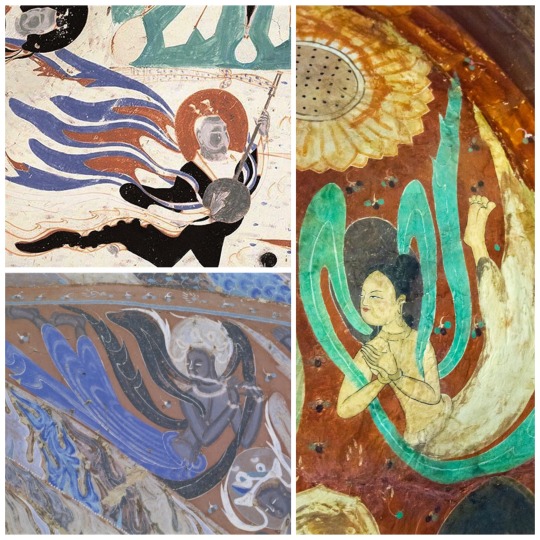
Left to right: Cave No. 461, detail of mural in the roof of the cave depicting either a flying apsara or a celestial musician. Western Wei dynasty (535–556 CE). Artist unknown. Mogao Grottoes, Dunhuang, China [image source].
Cave 285 flying apsara (feitian) in one of the Mogao Caves. Western Wei Dynasty (535–556 CE), Artist unknown. Photo taken by Keren Su for Getty Images. Mogao Grottoes, Dunhuang, China [image source].
Cave 249. Mural painting of feitian playing a flute, Western Wei Dynasty (535-556 CE). Image courtesy by Wang Kefen from The Complete Collection of Dunhuang Grottoes, Vol. 17, Paintings of Dance, The Commercial Press, Hong Kong, 2001, p. 15. Mogao Grottoes, Dunhuang, China [image source].
I theorize that it is likely that the pibo was introduced to China via Buddhism and Buddhist iconography that depicted apsaras (feitian) and other deites wearing uttariya and translated it to dajin.
3. Trickle down fashion: Buddhism’s journey to the East.
However, since Buddhism and its Indian-based fashion spread to West Asia first, to Sassanian Persians and Sogdians, it is likely that, by the time it reached the Han Chinese in the first century CE, it came with Persian and Sogdian influence. Persians’ fashion during the Sassanian Empire (224–651 CE) was influenced by Greeks (hellenization) who also had a a thin long scarf-like garment called an epliblema ἐπίβλημα, often depicted in amphora (vases) of Greek theater scenes and sculptures of deities.

Left to right: Dame Baillehache from Attica, Greece. 3rd century BCE, Hellenistic period (323-30 BCE), terracotta statuette. Photo taken by Hervé Lewandowski. Louvre Museum, Paris, France [image source].
Deatail view of amphora depicting the goddess Artemis by Athenian vase painter, Andokides, ca. 525 BCE, terracotta. Found in Vulci, Italy. Altes Museum, Berlin, Germany [image source].
Statue of a Kore (young girl), ca. 570 BCE, Archaic Period (700-480 BCE), marble. Artist unknown. Uncovered from Attica, Greece. Acropolis Museum, Athens, Greece [image source].
Detail view of Panathenaic (Olympic Games) prize amphora with lid, 363–362 BCE, Attributed to the Painter of the Wedding Procession and signed by Nikodemos, terracotta. Uncovered from Athens, Greece. J. Paul Getty Museum, Los Angeles, California, United States [image source].
Roman statue depicting Euterpe, muse of lyric poetry and music, ca. 2nd century CE, marble, Artist unknown. From the Villa of G. Cassius Longinus near Tivoli, Italy. Photo taken by Egisto Sani on March 12, 2012, Vatican Museums, Rome, Italy [image source].
Greek (or Italic) tomb mural painting from the Tomb of the Diver, ca. 470 BCE, fresco. Artist unknown. Photo taken by Floriano Rescigno. Necropolis of Paestum, Italy [image source].
Below are Iranian and Iraqi period representations of this long thin scarf.

Left to right: Closeup of ewer likely depicting a female dancer from the Sasanian Period (224–651 CE) in ancient Persia , Iran, 6th-7th century CE, silver and gilt. Artist unknown. Mary Harrsch. July 10, 2015. Arthur M. Sackler Gallery of Asian Art, Smithsonian, Washington D.C [image source].
Ewer with nude dancer probably representing a maenad, companion of Dionysus from the Sasanian Period (224–651 CE) in ancient Persia, Iran, 6th-7th century CE, silver and gilt. Artist unknown. Mary Harrsch. July 16, 2015. Arthur M. Sackler Gallery of Asian Art, Smithsonian, Washington D.C [image source].
Painting reconstructing the image of unveiled female dancers depicted in a fresco, Early Abbasid period (750-1258 CE), about 836-839 CE from Jawsaq al-Khaqani, Samarra, Iraq. Museum of Turkish and Islamic Art, Istanbul [image source].
The earliest depictions of Buddha in China, were very similar to West Asian depictions. Ever wonder why Buddha wears a long draped robe similar to a Greek himation (Romans called it toga)?
Take a look below at how much the Greeks influenced the Kushans in their art and fashion. The top left image is one of the earliest depictions of Buddha in China. Note the similarities between it and the Gandhara Buddha on the right.
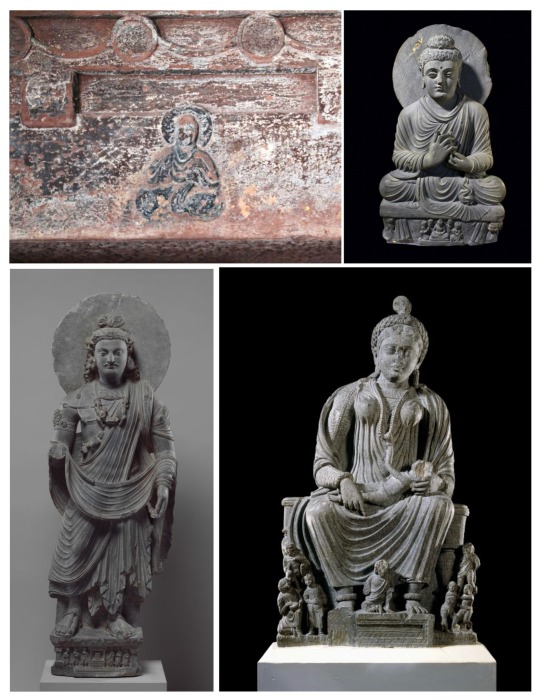
Left: Seated Buddha, Mahao Cliff Tomb, Sichuan Province, Eastern Han Dynasty, late 2nd century C.E. (photo: Gary Todd, CC0).
Right: Seated Buddha from Gandhara, Pakistan c. 2nd–3rd century C.E., Gandhara, schist (© Trustees of the British Museum)
Standing Bodhisattva Maitreya (Buddha of the Future), ca. 3rd century, gray schist. From Gandhara, Pakistan. Image credit to The Metropolitan Museum of Art, New York City, United States [image source].
Statue of seated goddess Hariti with children, ca. 2nd to 3rd centuries CE, schist. Artist unknown. From Gandhara, Pakistan. The British Museum, London, England [image source].
Before Buddhism spread outside of Northern India (birthplace), Indians never portrayed Buddha in human form.
Early Buddhist art is aniconic, meaning the Buddha is not represented in human form. Instead, Buddha is represented using symbols, such as the Bodhi tree (where he attained enlightenment), a wheel (symbolic of Dharma or the Wheel of Law), and a parasol (symbolic of the Buddha’s royal background), just to name a few. […] One of the earliest images [of Buddha in China] is a carving of a seated Buddha wearing a Gandharan-style robe discovered in a tomb dated to the late 2nd century C.E. (Eastern Han) in Sichuan province. Ancient Gandhara (located in present-day Afghanistan, Pakistan, and northwest India) was a major center for the production of Buddhist sculpture under Kushan patronage. The Kushans occupied portions of present-day Afghanistan, Pakistan, and North India from the 1st through the 3rd centuries and were the first to depict the Buddha in human form. Gandharan sculpture combined local Greco-Roman styles with Indian and steppe influences (Chaffin, 2022).
In the Mogao Caves, which contain some of the earliest Buddhist mural paintings in China, we see how initial Chinese Buddhist art depicted Indian fashion as opposed to the later hanfu-inspired garments.

Left to right: Cave 285, detail of wall painting, Western Wei dynasty (535–556 CE). Mogao Grottoes, Dunhuang, China. Courtesy the Dunhuang Academy [image source]. Note the clothes the man is wearing. It looks very similar to a lungi (a long men’s skirt).
Photo of Indian man sitting next to closed store wearing shirt, scarf, lungi and slippers. Paul Prescott. February 20, 2015. Varanasi, India [image source].
Cave 285, mural depiction of worshipping bodhisattvas, 6th century CE, Wei Dynasty (535-556 A.D.), Unknown artist. Mogao Grottoes, Dunhuang, China. Notice the half bow on his hips. That is a common style of tying patka (also known as pataka; cloth sashes) that we see throughout Indian history. Many of early Chinese Buddhist paintings feature it, including the ones at Mogao Caves.
Indian relief of Ashoka wearing dhoti and patka, ca. 1st century BC, Unknown artist. From the Amaravathi village, Guntur district, Andhra Pradesh, India. Currently at the Guimet Museum, Paris [image source].
Cave 263. Mural showing underlying painting, Northern Wei Dynasty (386–535 CE). Artist Unknown. Picture taken November 29, 2011, Mogao Grottoes, Dunhuang, China [image source]. Note the pants that look to be dhoti.
Comparison photo of modern dhoti advertisement from Etsy [image source].
Spread of Buddhism to East Asia.

Map depicting the spread of Buddhism from Northern India to the rest of Asia. Gunawan Kartapranata. January 31, 2014 [image source]. Note how Mahayana Buddhism arrived to China after passing through Kushan, Bactrean, and nomadic steppe lands, absorbing elements of each culture along the way.
Wealthy Buddhist female patrons emulated the fantasy fashion worn by apsaras, specifically, the uttariya/dajin and adopted it as an everyday component of their fashion.

Cave 285. feitian mural painting on the west wall, Western Wei Dynasty (535–556 CE). Artist unknown. Mogao Grottoes, Dunhuang, China [image source].
Cave 285. Detail view of offering bodhisattvas (bodhisattvas making offers to Buddha) next to the phoenix chariot on the Western wall of the cave. Western Wei Dynasty (535–556 CE). Artist unknown. Mogao Grottoes, Dunhuang, China [image source].
Cave 61 Khotanese (from the kingdom of Khotan 于阗 [56–1006 CE]) donor ladies, ca. 10th century CE, Five Dynasties period (907 to 979 CE). Artist unknown. Picture scanned from Zhang Weiwen’s Les oeuvres remarquables de l'art de Dunhuang, 2007, p. 128. Uploaded to Wikimedia Commons on October 11, 2012 by Ismoon. Mogao Grottoes, Dunhuang, China [image source].
Detail view of Ladies Adorning Their Hair with Flowers 簪花仕女图, late 8th to early 9th century CE, handscroll, ink and color on silk, Zhou Fang 周昉 (730-800 AD). Liaoning Provincial Museum, Shenyang, China [image source].
Therefore, the theory I propose of how the pibo entered East Asia is:
India —> Greek influenced West Asia (Sassanian Persians, Sogdians, Kushans, etc…) —> Han China —> Rest of East Asia (Three Kingdoms Korea, Asuka Japan, etc…)
Thus, the most likely theory, in my person opinion, is Buddhist iconography depicting uttariya encountered Greek-influenced West Asian Persian, Sogdian, and Kushan shawls, which combined arrived to China but wouldn’t become commonplace there until the explosion in popularity of Buddhism from the periods of Northern and Southern Dynasties to Song.
References:
盧秀文; 徐會貞. 《披帛與絲路文化交流》 [The brocade scarf and the cultural exchanges along the Silk Road]. 敦煌研究 (中國: 敦煌研究編輯部). 2015-06: 22 – 29. ISSN 1000-4106.
#hanfu#chinese culture#chinese history#buddhism#persian#sogdian#kushan#gandhara#indian fashion#uttariya#pibo#history#asian culture#asian art#asian history#asian fashion#east asia#south asia#india#pakistan#iraq#afghanistan#sassanian#silk road#fashion history#tang dynasty#eastern han dynasty#cultural exchange#greek fashion#mogao caves
293 notes
·
View notes
Photo

From “Little Ladies Museum”, Dayanita Singh.
Dayanita Singh was born in New Delhi in 1961 and studied at the National Institute of Design in Ahmedabad and the International Center of Photography in New York. Her work has been exhibited at institutions including the Museum of Modern Art, New York; Tate Modern, London; the Art Institute of Chicago; Hayward Gallery, London; the Kiran Nadar Museum of Art, New Delhi; and the Tokyo Photographic Art Museum. In 2013 she represented Germany at the Venice Biennale. Bookmaking is central to Singh’s practice.
Her books with Steidl include Privacy (2004), Chairs (2005), Go Away Closer (2007), Sent a Letter (2007), Dream Villa (2010), File Room (2013), Museum of Chance (2014), Museum Bhavan (2017)—Book of the Year at the 2017 Paris Photo–Aperture Foundation Photobook Awards and winner of the 2018 ICP Infinity Award for Artist’s Book—and Zakir Hussain Maquette (2019). Singh is the 2022 Hasselblad Award recipient.
9 notes
·
View notes
Text
Catching up on reading some articles I had saved, and arrived at the one's about the National Gallery of Modern Art's exhibition about Jana Shakti, which is supposed to be artists making art based off the Prime Minister's radio show which is essentially a monologue. I haven't seen the show yet, cause the NGMA website does not tell me when it will be coming to my city.
These articles call out artists who are siding with the current regime, which has been co-opting all forms of media to suit their right wing Hindutva agenda. But my concern as a young museum practioner, has been the museums and art insitutions themselves.
The National Gallery of Modern Art, which is headquartered at Delhi has a massive collection of 'modern art' which in Indian is begins from the late 1800s to contemporary times. What is the status of these collections? What are they doing with paintings and works by artists who the regime does not approve of? How are the collections being safeguarded? How do we trust the curators of his central government run institutions to stand by freedom of expression when they seem to be tripping over themselves to please authority? How do we pry culture away from the grimy hands of the government and make it about the people on the ground, again and maybe for once? How do we create larger alternate spaces for art, culture and expression?
The solution is obviously not private funding, cause we see how the major business houses which have always supported art and culture are painting themselve in saffron.
4 notes
·
View notes
Text
Golden Triangle tour 4 Days
The Golden Triangle tour 4 days is one of the most popular tourist circuits in India, encompassing the cities of Delhi, Agra, and Jaipur. In just four days, you can experience the rich cultural heritage, architectural marvels, and vibrant history of these three iconic destinations. Let's embark on a virtual journey through the All Golden Triangle tours.

Certainly! Here are some additional details about the 4 Days Golden Triangle tour:
Delhi:
Delhi, the capital city of India, is a vibrant metropolis with a rich history spanning over several centuries. The city is divided into two parts: Old Delhi and New Delhi. Old Delhi is known for its narrow lanes, bustling markets, and historical landmarks, while New Delhi showcases modern architecture and wide boulevards.
Some other notable attractions in Delhi include:
Lotus Temple: Famous for its unique lotus-shaped architecture, this Bahá'í House of Worship is a serene place for meditation and introspection.
Raj Ghat: Visit the memorial dedicated to Mahatma Gandhi, the Father of the Nation, at this tranquil spot where he was cremated.
National Museum: Explore the vast collection of art, artifacts, and archaeological treasures that depict India's history and cultural heritage.
Agra:
Agra, located in the state of Uttar Pradesh, is home to the world-famous Taj Mahal, one of the Seven Wonders of the World. This magnificent marble mausoleum was built by Emperor Shah Jahan in memory of his beloved wife, Mumtaz Mahal. The Taj Mahal's architectural brilliance, intricate carvings, and symmetrical gardens make it an unforgettable sight.
In addition to the Taj Mahal, Agra offers other attractions, such as:
Fatehpur Sikri: Just a short distance from Agra, this UNESCO World Heritage site is a well-preserved ghost city built by Emperor Akbar. Explore the grand palaces, courtyards, and mosques within its walls.
Mehtab Bagh: Situated across the Yamuna River from the Taj Mahal, this garden provides a picturesque view of the monument, especially during sunset.
Wildlife SOS: If you're interested in conservation efforts, you can visit Wildlife SOS, an organization that rescues and rehabilitates elephants and bears.
Jaipur:
Jaipur, the capital city of Rajasthan, is known for its vibrant culture, majestic forts, and palaces. The city's nickname, the "Pink City," comes from the distinctive pink hue of its historic buildings.
Apart from the attractions mentioned earlier, Jaipur offers the following highlights:
Nahargarh Fort: Set on a hilltop, this fort offers panoramic views of the city and is a popular spot to watch the sunset.
Jaipur City Palace: Explore the stunning architecture, courtyards, and museums within this grand palace complex, which is still inhabited by the royal family.
Jaigarh Fort: Known for its massive cannon, "Jaivana," this fort offers insights into the military history of Rajasthan.
Chokhi Dhani: Experience a taste of Rajasthani culture and hospitality at this ethnic village resort, where you can enjoy traditional music, dance, and cuisine.
#vacations#traveling#wanderlust#places to visit#holiday#tourism#travel#travel photography#india#united kingdom#london#usa#destination
4 notes
·
View notes
Text
The Vibrant Canvas: Exploring Visual Arts in Delhi
Delhi, the capital city of India, is not only renowned for its rich historical and cultural heritage, but it also boasts a thriving and diverse Visual Arts scene. From ancient murals and traditional crafts to contemporary galleries and cutting-edge exhibitions, Delhi provides a fascinating tapestry of visual art forms that captivate both locals and tourists alike. In this article, we will delve into the vibrant world of visual arts in Delhi, exploring its historical roots, modern expressions, and the platforms that contribute to its continual evolution.

Historical Legacy:
Delhi’s visual arts legacy is deeply intertwined with its historical journey. The city’s monumental architecture, spanning from the Qutub Minar to the Red Fort, serves as a testament to the artistic prowess of various dynasties that ruled the region. Intricate Mughal frescoes and exquisite Persian-style miniatures tell stories of an era long gone by, showcasing the melding of cultures that shaped Delhi’s identity. The Humayun’s Tomb complex, a UNESCO World Heritage Site, stands as an exemplar of Mughal garden design and architectural elegance.
Traditional Crafts and Artistry:
Delhi’s cultural landscape is enriched by a myriad of traditional crafts and art forms that have been passed down through generations. The bustling lanes of Old Delhi are home to bustling bazaars where artisans skillfully create mesmerizing textiles, intricate jewelry, and stunning pottery. The art of Zardozi, the elaborate embroidery technique, and Meenakari, the enameling tradition, continue to thrive, connecting the past with the present.
Contemporary Galleries and Exhibitions:
As the city has evolved, so too has its visual arts scene. Modern Delhi is a hub for contemporary galleries and exhibition spaces that showcase the cutting-edge works of emerging and established artists. The National Gallery of Modern Art (NGMA) serves as a repository of Indian modern art, featuring a diverse collection of paintings, sculptures, and installations that reflect the changing socio-political landscape. Prominent galleries like the Kiran Nadar Museum of Art and the Devi Art Foundation provide platforms for experimental art forms and interdisciplinary collaborations.
Street Art and Urban Expression:
Delhi’s streets have become a canvas for street artists who use public spaces to express their creativity and engage with the public. Graffiti, murals, and installations adorn walls, bridges, and alleyways, transforming mundane surroundings into vibrant visual narratives. The Lodhi Art District, a street art initiative, has breathed new life into the Lodhi Colony area, turning it into an open-air gallery where local and international artists converge to create captivating murals.
Art Festivals and Cultural Events:
The city’s cultural calendar is punctuated by numerous art festivals and events that celebrate the visual arts. The India Art Fair, a prestigious annual event, brings together galleries, collectors, and artists from around the world, offering a comprehensive overview of contemporary art trends. The Delhi International Arts Festival showcases a diverse range of art forms, including visual arts, dance, music, and theater, fostering cross-cultural interactions and creative exchange.
Preserving Heritage and Fostering Innovation:
While embracing its historical heritage, Delhi also encourages innovation and experimentation in the visual arts. The Sanskriti Kendra, an artist residency program, provides a nurturing environment for artists to engage with traditional crafts and techniques while exploring new directions. Institutes like the College of Art and the Jamia Millia Islamia’s Faculty of Fine Arts play a pivotal role in nurturing young talents and encouraging artistic exploration
Delhi’s visual arts landscape is a dynamic interplay of tradition and modernity, where ancient artistry harmoniously coexists with contemporary expressions. The city’s historical legacy, vibrant traditional crafts, flourishing galleries, street art movement, and cultural events collectively contribute to its thriving visual arts scene. As Delhi continues to evolve, it remains a hub of creative energy, offering a visual feast that reflects the diverse and ever-changing cultural tapestry of the city.
2 notes
·
View notes
Text
The “Dancing Girl” of Mohenjo-Daro

Dancing Girl is a prehistoric bronze sculpture made in lost-wax casting about c. 2300–1750 BC in the Indus Valley civilisation city of Mohenjo-daro (in modern-day Pakistan),[1] which was one of the earliest cities. The statue is 10.5 centimetres (4.1 in) tall, and depicts a nude young woman or girl with stylized ornaments, standing in a confident, naturalistic pose. Dancing Girl is highly regarded as a work of art.
The statue was excavated by British archaeologist Ernest Mackay in the "HR area" of Mohenjo-daro in 1926,[2] It is now in the National Museum, New Delhi; having been allocated to India at the Partition of India in 1947.
Source: https://en.wikipedia.org/wiki/Dancing_Girl_(sculpture)
10 notes
·
View notes
Text
Museum of Modern Art in Delhi

The workshops at this museum of modern art in Delhi include interactive programs for kids of all ages to participate and learn. Children are encouraged through the sessions to get an initiation into the world of art through stimulating conversations, performances, art-making, and demonstrations. Kids encounter and get introduced to the world through stories on art history and by seeing varied artworks ranging from historical to modern art.
1 note
·
View note
Text
Top 5 Out of the Box Sonam Kapoor Movies
Sonam kapoor Indian actress Ahuja performs in Hindi-language movies. She has received a National Film Award and a Filmfare Award, and from 2012 to 2016, she was listed among Forbes India's Celebrity 100 based on her popularity and earnings.
Fashion and Sonam Kapoor go hand in hand. And enjoyment too. It's no secret that we enjoy Sonam Kapoor's choice of entertaining films to act in. Her films frequently have a carefree, sunny, perfect day feel. Popcorn movies at their very best.
Aisha

Rajshree Ojha is the director of the 2010 Hindi-language romantic comedy-drama Aisha. Sonam Kapoor, Abhay Deol, Ira Dubey, Cyrus Sahukar, Amrita Puri, Anand Tiwari, Arunoday Singh, and Lisa Haydon are all part of the ensemble cast in this comedy of manners. It is a version of Jane Austen's 1815 novel Emma and is set in the upper-class society of Delhi, India. It has the same tone as the cult Hollywood movie Clueless (1995), which is also an adaptation of Austen's book. Aisha, which debuted on August 6, 2010, had a mediocre box office performance. Critics gave it mixed to favourable reviews. She characterised her persona as an intrusive diva with a penchant for playing Cupid and matchmaking.
2.Neerja

The 2016 Indian biographical thriller film Neerja, which was written by Saiwyn Quadras and Sanyuktha Chawla Shaikh, was directed by Ram Madhvani. The narrative is based on a true incident: the attempted hijacking of Pan Am Flight 73 by the Abu Nidal Organization, which was supported by Libya, on September 5, 1986 in Karachi, Pakistan. The head purser of the flight, Neerja Bhanot, who stopped the hijack attempt by warning the pilots and forcing them to ground the aircraft, is portrayed in the movie. Bhanot lost his life while attempting to save the 359 survivors among the 379 passengers and crew. She played the role of the air hostess Neerja Bhanot, who perished in 1986 while attempting to save the passengers of Pan Am Flight 73, which had been hijacked.
Since the project is based on actual events, Kapoor felt a sense of responsibility towards it. As part of her role preparation, she met the Bhanot family. The movie received a lot of positive reviews, and many critics thought that Kapoor gave her best performance to date. According to Raja Sen, her performance was a career-defining moment, and Rohit Vats of the Hindustan Times observed that "she carries entirely on her shoulder." She conveys a mixture of sincere, fear, goodwill, and boldness. Rajeev Masand invited Kapoor to his yearly best actresses roundtable, and Sen named Kapoor the best actress in Hindi film of 2016. In addition to numerous other honours, Kapoor received a Special Mention for a National Film Award and a Filmfare Award for Best Actress (Critics).
3. Raanjhanaa

Beloved One, also known as Raanjhanaa, is a 2013 Indian Hindi-language romantic drama film that was written and directed by Aanand L. Rai. Kapoor played the part of Varanasi-based Muslim student Zoya Haider, who becomes involved in politics as a result of the murder of her Sikh lover. Kapoor met with students, went to workshops, and practised with theatre groups affiliated with Jawaharlal Nehru University in order to get ready for her role. Additionally, she looked at Jaya Bachchan's performance in Guddi (1971), which she thought was "ideal" for the part. In response to a question about her role in the movie, Kapoor gave the following explanation of her acting style: "I have always tried to do diverse films and… I strive to be different for every character. The film was superhit at box office.
4. Delhi 6
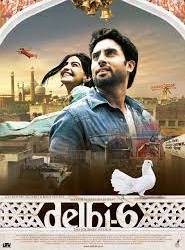
Rakesh Omprakash Mehra is the director of the 2009 drama film Delhi-6, which was made in Hindi. Abhishek Bachchan plays an NRI in the movie who travels to India with his elderly grandmother (Waheeda Rehman) and starts learning about his ancestry before becoming involved in a religious issue involving an unknown attacker who resembles a monkey. After receiving its world debuts at the Museum of Modern Art and the Dubai International Film Festival, Delhi-6 was finally released on February 20, 2009, to critical and box office acclaim. Although it did poorly financially, it earned mixed reviews from critics, who praised the soundtrack and the cast's performances while criticising the plot, writing, and pacing. Best Production Design went to Delhi-6 at the 57th National Film Awards (Samir Chanda).
5. Veere Di Wedding

Female buddy comedy Veere Di Wedding is a 2018 Hindi-language movie that was produced by Rhea Kapoor, Ekta Kapoor, and Nikhil Dwivedi and directed by Shashanka Ghosh. Starring Kareena Kapoor Khan, Sonam K. Ahuja, Swara Bhaskar, and Shikha Talsania as four friends attending a wedding, the movie is loosely based on the 2015 movie The Wedding Ringer. On June 1, 2018, Veere Di Wedding was released in theatres to mixed reviews. The movie, which had a budget of $28,000,000, ended up earning over 139,000,000 globally, making it the highest-grossing Hindi film of the year and the biggest for a movie with female leads. At the 64th Filmfare Awards, it garnered three nominations, including Best Supporting Actress for Talsania and Bhaskar.
2 notes
·
View notes
Text




Kiran Nadar is the Chairperson, Kiran Nadar Museum of Art and a trustee of the Shiv Nadar Foundation. Besides being an avid art collector, she is an acclaimed international bridge player and a philanthropist.
She is a key driver behind demystifying art to the common man through the KNMA, a philanthropic initiative in art. She has been acknowledged as a ‘hero of philanthropy’ by Forbes Asia Magazine in 2010 for launching India’s first philanthropic private museum.
Kiran is a Trustee of the Shiv Nadar Foundation, which among its transformational educational initiatives has established the SSN College of Engineering in Chennai, today among the top private engineering colleges in India, Shiv Nadar University, VidyaGyan schools, Shiv Nadar School and the Kiran Nadar Museum of Art. Drawing from her diverse and rich experience in advertising and communications, Kiran plays a very important role in defining the architecture and the aesthetics of the Foundation’s initiatives.
Kiran is also member of the Rasaja Foundation, an educational, scientific and cultural institution created in 1984 by the late Jaya Appasamy, a renowned artist, art historian and art critic. As a representative of the Foundation, she has also been involved in a joint initiative with the Rajiv Gandhi Foundation to promote the education of the Dalit and Muslim girl child in some of the most backward districts in the State of Uttar Pradesh in India. She is also an International Council member of Museum of Modern Art, New York (MoMA)
An advertising, communications and brand professional by background, Kiran started her career at MCM. Then came her stint at NIIT - a company that grew out of Shiv Nadar's vision for computer education in India. Kiran was responsible for shaping the NIIT brand in its formative years with Rajendra Pawar and was closely involved in its brand building strategy. She is one of the top Indian players of competitive bridge as a member of the “Formidables” team, and has not only won many laurels at the National level but has also represented India several times in international competitive bridge events.
Kiran lives in Delhi, India with her husband Shiv Nadar, Founder, HCL and Chairman, Shiv Nadar Foundatio
2 notes
·
View notes
Text
Top Attractions to Visit on a Golden Triangle Tour with Varanasi

Embarking on a Golden Triangle Tour with Varanasi offers an unparalleled glimpse into India's rich cultural tapestry, historical grandeur, and spiritual depth. This unique itinerary encompasses the bustling capital city of Delhi, the architectural marvels of Agra, the regal splendour of Jaipur, and the sacred tranquillity of Varanasi. Each destination in this quadrilateral journey promises an immersive experience that is both enlightening and unforgettable.
Delhi: A Mélange of History and Modernity
Red Fort: The Epitome of Mughal Grandeur
Delhi, the heart of India, is where ancient traditions blend seamlessly with contemporary advancements. Begin your Golden Triangle Tour with Varanasi at the iconic Red Fort, a UNESCO World Heritage Site. Built by Emperor Shah Jahan, the fort's red sandstone walls have witnessed centuries of history. As you stroll through its vast courtyards and ornate halls, you can almost hear the echoes of past emperors.
Qutub Minar: An Architectural Marvel
Next, visit the Qutub Minar, the tallest brick minaret in the world. This 73-meter tall tower, adorned with intricate carvings and verses from the Quran, stands as a testament to the architectural ingenuity of the Delhi Sultanate. The surrounding Qutub complex, with its ancient ruins and the Iron Pillar, offers a glimpse into the region’s Islamic heritage.
Humayun’s Tomb: The Precursor to the Taj Mahal
Humayun’s Tomb, another UNESCO World Heritage Site, is a precursor to the Taj Mahal and an exemplary model of Mughal architecture. The lush gardens and symmetrical design of the tomb provide a serene escape from the city's hustle and bustle.
India Gate and Rashtrapati Bhavan: Symbols of a Modern Nation
Conclude your Delhi exploration with a visit to India Gate, a war memorial dedicated to Indian soldiers, and Rashtrapati Bhavan, the official residence of the President of India. These landmarks, along with the nearby Parliament House, embody the democratic spirit and modern identity of India.
Agra: The City of Eternal Love
Taj Mahal: A Monument of Love
No Golden Triangle Tour with Varanasi is complete without witnessing the ethereal beauty of the Taj Mahal. This white marble mausoleum, built by Shah Jahan in memory of his beloved wife Mumtaz Mahal, is a symbol of eternal love. The intricate inlay work, the symmetry of its gardens, and the reflection of the monument in the Yamuna River create an awe-inspiring sight, especially at sunrise and sunset.
Agra Fort: A Fortress of Power
A short distance from the Taj Mahal lies the Agra Fort, another UNESCO World Heritage Site. This red sandstone fort, with its formidable walls and grand palaces, was the main residence of the Mughal emperors. The Diwan-i-Aam (Hall of Public Audience) and Diwan-i-Khas (Hall of Private Audience) are particularly noteworthy for their architectural brilliance.
Fatehpur Sikri: A Mughal Marvel
A visit to Fatehpur Sikri, the erstwhile capital of the Mughal Empire, is a journey back in time. This ghost city, built by Akbar the Great, is renowned for its well-preserved palaces, courtyards, and mosques. The Buland Darwaza, one of the largest gateways in the world, and the Jama Masjid are must-see attractions.
Jaipur: The Pink City
Amber Fort: A Majestic Stronghold
Jaipur, the vibrant capital of Rajasthan, is a city of forts and palaces. Start your Jaipur adventure at the Amber Fort, perched on a hilltop overlooking Maota Lake. The fort's blend of Hindu and Mughal architecture, along with its exquisite mirror work and frescoes, make it a visual delight. An elephant ride to the fort's entrance adds a royal touch to your visit.
City Palace: A Royal Residence
In the heart of Jaipur lies the City Palace, a sprawling complex of courtyards, gardens, and buildings. The palace is still home to the royal family and houses a museum displaying an impressive collection of art, textiles, and artifacts. The Chandra Mahal and Mubarak Mahal within the palace complex are architectural masterpieces.
Hawa Mahal: The Palace of Winds
The Hawa Mahal, with its unique five-story facade featuring 953 small windows, is one of Jaipur’s most iconic landmarks. This "Palace of Winds" was designed to allow royal ladies to observe street festivals while remaining unseen by the public. The latticework on the windows creates a beautiful interplay of light and shadow.
Jantar Mantar: An Astronomical Marvel
The Jantar Mantar observatory, built by Maharaja Jai Singh II, is a UNESCO World Heritage Site and an astronomical marvel. The collection of nineteen architectural astronomical instruments allows for the observation of celestial bodies with the naked eye. The Samrat Yantra, the largest sundial in the world, is a highlight of this site.
Varanasi: The Spiritual Heart of India
Ganges River: A Sacred Lifeline
Concluding your Golden Triangle Tour with Varanasi, the holy city of Varanasi offers a stark contrast to the architectural splendours of Delhi, Agra, and Jaipur. The Ganges River, considered the most sacred river in Hinduism, flows through this ancient city. The ghats (riverfront steps) of Varanasi are the focal point of spiritual activities. Witness the Ganga Aarti, a mesmerising ritual of worship involving fire, music, and chanting, performed daily at the Dashashwamedh Ghat.
Kashi Vishwanath Temple: A Sacred Sanctuary
The Kashi Vishwanath Temple, dedicated to Lord Shiva, is one of the most revered temples in India. The temple's golden spire and the jyotirlinga (a devotional representation of Shiva) attract millions of pilgrims seeking spiritual solace. The narrow lanes leading to the temple are lined with shops selling religious paraphernalia, creating a vibrant atmosphere.
Sarnath: A Buddhist Pilgrimage Site
A short distance from Varanasi lies Sarnath, a significant Buddhist pilgrimage site. It was here that Lord Buddha delivered his first sermon after attaining enlightenment. The Dhamek Stupa, the Chaukhandi Stupa, and the Sarnath Archaeological Museum, which houses the Lion Capital of Ashoka (India’s national emblem), are key attractions in Sarnath.
Banaras Hindu University: A Seat of Learning
Established in 1916, the Banaras Hindu University (BHU) is one of Asia's largest residential universities. The sprawling campus is home to the Bharat Kala Bhavan museum, which showcases a rich collection of Indian art, and the Vishwanath Temple, an architectural marvel in its own right.
Experiencing the Local Culture and Cuisine
Delhi’s Culinary Delights
Delhi's culinary scene is as diverse as its cultural heritage. From the bustling street food markets of Chandni Chowk to the upscale restaurants in Connaught Place, Delhi offers a gastronomic journey that includes delectable chaats, succulent kebabs, and rich Mughlai curries.
Agra’s Petha and Mughlai Cuisine
In Agra, indulge in the city's famous petha (a sweet made from ash gourd) and Mughlai cuisine. The rich flavours of biryanis, kebabs, and kormas reflect the culinary legacy of the Mughal era.
Jaipur’s Rajasthani Feasts
Jaipur is renowned for its royal Rajasthani cuisine. Savor dishes like dal bati churma (lentils, wheat balls, and sweetened cereal), laal maas (spicy red meat curry), and ghewar (a traditional sweet). The vibrant bazaars of Jaipur are also perfect for sampling local snacks and sweets.
Varanasi’s Street Food and Prasad
Varanasi's street food scene is a delightful mix of flavors. Try the famous kachori sabzi (spicy fried bread with potato curry), tamatar chaat (a tangy tomato-based snack), and the signature Banarasi paan (betel leaf preparation). Additionally, the prasad (sacred food offering) from temples is a must-try for its spiritual significance and unique taste.
Practical Tips for Your Journey
Best Time to Visit
The best time to embark on a Golden Triangle Tour with Varanasi is during the cooler months from October to March. The weather during this period is pleasant, making it ideal for sightseeing and outdoor activities.
Travel Essentials
Ensure you carry comfortable clothing, a good pair of walking shoes, and essential medications. Sunscreen, hats, and sunglasses are recommended for protection against the sun. Respect local customs and dress modestly, especially when visiting religious sites.
Transportation
While air travel is the quickest way to cover long distances, trains and private cars offer a more scenic and immersive experience. India's extensive rail network connects all major cities, and hiring a private car with a driver can provide flexibility and comfort.
Safety and Health
Stay hydrated and prefer bottled water to avoid waterborne illnesses. Be cautious with street food and ensure it is prepared in hygienic conditions. Carry a basic first aid kit and consult your doctor for any necessary vaccinations before your trip.
Conclusion
A Golden Triangle Tour with Varanasi is a journey through time, offering a kaleidoscope of experiences that reflect India’s rich heritage and vibrant culture. From the architectural wonders of Delhi, Agra, and Jaipur to the spiritual sanctity of Varanasi, this tour is a comprehensive exploration of India’s historical and cultural treasures. Each destination, with its unique charm and significance, contributes to a deeper understanding of the country’s diverse tapestry. As you traverse through these iconic cities, you will not only witness their grandeur but also feel the pulse of India's timeless spirit.
0 notes
Text
Famous Museums of Delhi

National Museum: The National Museum is one of largest museums of India, showcasing a vast collection of artifacts from prehistoric times to modern history. It features sculptures, paintings, manuscripts, and decorative arts, offering a glimpse of cultural heritage and history.
National Gallery of Modern Art (NGMA): The NGMA houses an extensive collection of modern and contemporary Indian art. It includes works by prominent artists like Raja Ravi Varma, Rabindranath Tagore, and Amrita Sher-Gil, providing insights into artistic evolution of india and diverse expressions of creativity.
National Museum of Natural History: This museum focuses on natural heritage of India, with exhibits on plants, animals, and geology. It includes a popular dinosaur gallery and educational displays that promote awareness about environmental conservation and biodiversity.
National Rail Museum: The National Rail Museum is dedicated to rail heritage. It features vintage locomotives, carriages, photographs, and interactive exhibits that illustrate the development of the Indian railway system and its impact on the country's socio-economic landscape.
Gandhi Smriti: Gandhi Smriti is the site where Mahatma Gandhi spent his last 144 days. The museum includes preserved rooms, personal artifacts, and multimedia exhibits that detail his life, philosophy, and contributions to indian independence movement.
Shankar's International Dolls Museum: This museum boasts a vast collection of dolls from around the world. The exhibits showcase traditional costumes and cultures, providing a unique perspective on global cultural diversity through the medium of dolls.
Crafts Museum: The Crafts Museum displays traditional Indian crafts, textiles, and folk art. The museum also features live demonstrations by artisans and a reconstructed village complex, highlighting rich and diverse craft traditions.
Delhi is home to several famous museums that offer a deep dive into the rich history, culture, and art of the city. Visiting these museums will be the best choice to escape the intense summer heat of Delhi. Hire a 𝐓𝐞𝐦𝐩𝐨 𝐓𝐫𝐚𝐯𝐞𝐥𝐥𝐞𝐫 𝐨𝐧 𝐑𝐞𝐧𝐭 and explore the rich culture and heritage through these amazing museums.
#travel#tour#tempotravellllerhire#tempotravelleronrent#tempotravelllerhiredelhi#delhitour#museums#museumsofdelhi#traveltoindia
0 notes
Photo





Nasreen Mohamedi (1937—1990) was an Indian artist best known for her line-based drawings, and is today considered one of the most essential modern artists from India. Despite being relatively unknown outside of her native country during her lifetime, Mohamedi's work has been the subject of remarkable revitalisation in international critical circles and has received popular acclaim over the last decade. Her work has been exhibited at the Museum of Modern Art (MoMA) in New York, the Kiran Nadar Museum of Art in New Delhi and other major museums.
18 notes
·
View notes